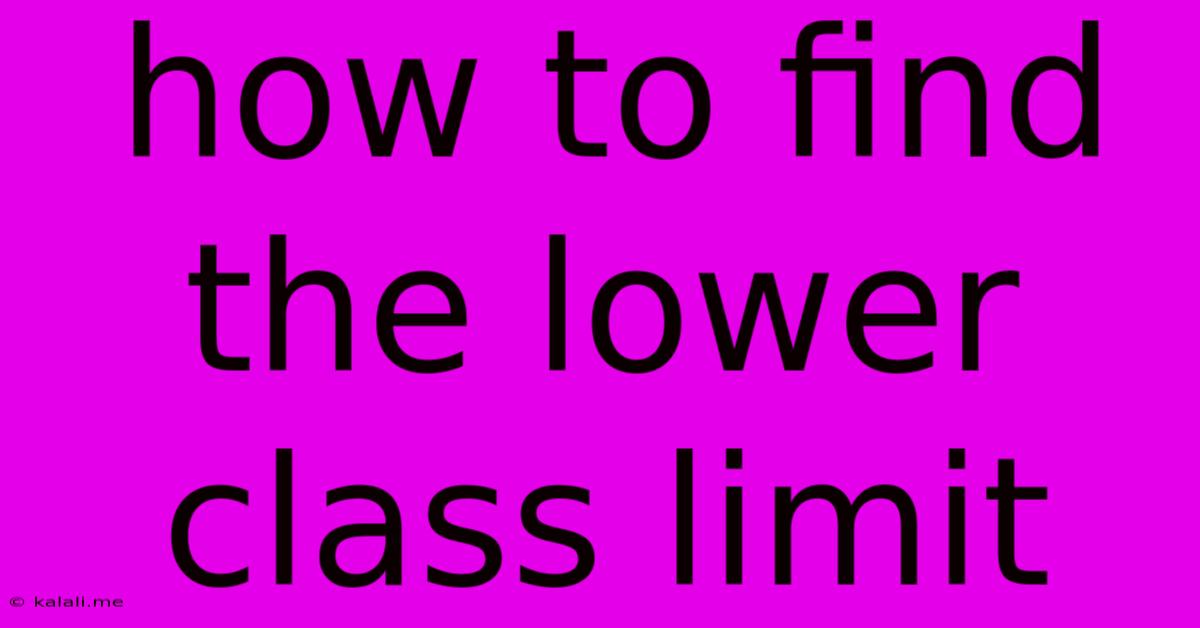How To Find The Lower Class Limit
Kalali
May 09, 2025 · 3 min read

Table of Contents
How to Find the Lower Class Limit: A Comprehensive Guide
Finding the lower class limit is a crucial step in data analysis, particularly when working with grouped frequency distributions. Understanding how to determine this value is essential for accurate interpretation of data and constructing effective statistical representations. This guide will walk you through various methods and scenarios to help you confidently calculate lower class limits.
What is a Lower Class Limit?
The lower class limit represents the smallest value that can belong to a particular class interval in a frequency distribution. It's the boundary below which a data point would fall into the preceding class. For example, in a class interval of 10-19, the lower class limit is 10. Understanding this foundational concept is key to grasping the following methods.
Methods for Determining the Lower Class Limit
The method for finding the lower class limit depends on the context of your data and how it's presented. Here are common scenarios:
1. Directly from the Class Interval:
This is the simplest case. If you're given a class interval, the lower class limit is readily apparent.
- Example: The class interval is 20-29. The lower class limit is 20.
2. From a Frequency Distribution Table:
Frequency distribution tables often list class intervals. The lower limit is the first number in each interval.
- Example:
| Class Interval | Frequency |
|---|---|
| 10-19 | 5 |
| 20-29 | 8 |
| 30-39 | 12 |
Here, the lower class limits are 10, 20, and 30.
3. Calculating from Class Width and the Number of Classes:
If you know the class width (the difference between consecutive lower class limits) and the number of classes, and the lowest value in your dataset, you can calculate the lower class limits.
-
Example: Let's say you have a class width of 5 and 4 classes. The lowest value in your dataset is 12.
- First Lower Class Limit: This will be the lowest value in your dataset rounded down to the nearest multiple of the class width. In this case, 12 would round down to 10.
- Subsequent Lower Class Limits: Add the class width to each subsequent lower class limit. So, you would have lower class limits of 10, 15, 20, and 25.
4. Dealing with Ungrouped Data:
If you have ungrouped data (individual data points), you'll need to first create a grouped frequency distribution. This involves:
- Determining the range: Find the difference between the highest and lowest values.
- Choosing the number of classes: This depends on the dataset size and desired level of detail. A common rule of thumb is to use between 5 and 15 classes.
- Calculating the class width: Divide the range by the number of classes and round up to a convenient value.
- Determining the lower class limit of the first class: This is usually the lowest value in your dataset rounded down to the nearest multiple of the class width. The subsequent lower class limits are derived by adding the class width repeatedly.
Importance of Correctly Identifying Lower Class Limits
Accuracy in identifying lower class limits is paramount for several reasons:
- Accurate Histograms: Incorrect limits will lead to misrepresentations in histograms and other visual representations of your data.
- Valid Statistical Calculations: Many statistical calculations, such as calculating measures of central tendency and dispersion, rely on correctly defined class intervals and their lower limits.
- Data Interpretation: Misidentified limits can lead to flawed interpretations of your data, affecting any conclusions drawn from your analysis.
By understanding these methods and paying close attention to detail, you can confidently determine the lower class limits for your data and ensure the accuracy of your analysis. Remember to always double-check your calculations and consider the context of your data to avoid errors.
Latest Posts
Latest Posts
-
Formation Of A Secondary Oocyte Occurs During
May 09, 2025
-
How Much Is 200ml In Ounces
May 09, 2025
-
Least Common Multiple Of 4 And 18
May 09, 2025
-
Which Is A Property Of Acids In Aqueous Solutions
May 09, 2025
-
What Is 15 Out Of 18 As A Percentage
May 09, 2025
Related Post
Thank you for visiting our website which covers about How To Find The Lower Class Limit . We hope the information provided has been useful to you. Feel free to contact us if you have any questions or need further assistance. See you next time and don't miss to bookmark.